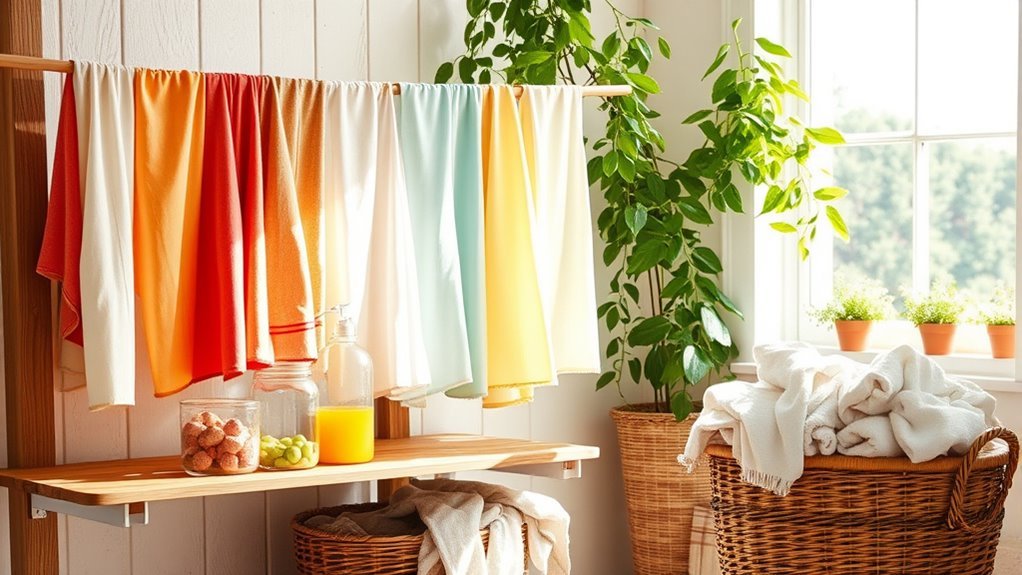Eco-Friendly Alternatives to Dryer
If you want to cut energy use and protect your clothes, air-drying is a great eco-friendly alternative to a traditional dryer. You can use indoor drying racks near windows or outdoors on clotheslines to save electricity while giving your garments a fresh scent. Heated airers also offer efficient drying with low power consumption. With tips on maximizing airflow and sunlight, plus fabric-friendly methods, you’ll discover smart ways to dry laundry sustainably and effectively.
Benefits of Air-Drying Clothes

Although using a dryer is quick, air-drying clothes offers several benefits you might not have considered. When you let your clothes dry naturally, you’re tapping into the power of air circulation, which helps them dry evenly and fresh without the harsh tumbling of a machine. This simple act not only saves energy but also gives you the freedom to avoid the wear and tear dryers can cause. Plus, good air circulation plays a key role in mold prevention by keeping your laundry dry and fresh, reducing the risk of musty smells and damp spots. Choosing air-drying means you’re embracing a more natural, eco-friendly routine that protects both your clothes and the environment, giving you peace of mind and independence.
Using Indoor Drying Racks
When choosing an indoor drying rack, you’ll want to take into account space-saving designs that fit your room without clutter. Look for racks made from durable materials like bamboo or metal to guarantee they last. To speed up drying, place your rack near a window or use a fan to improve air circulation.
Space-Saving Designs
If you’re short on space but want to dry clothes naturally, indoor drying racks offer a smart solution. They combine freedom with efficiency, letting you avoid bulky machines. Here’s how to make the most of compact drying solutions:
- Choose vertical drying racks to maximize floor space—they stand tall and hold more clothes.
- Look for foldable designs you can tuck away when not in use, keeping your living area open.
- Use wall-mounted racks that pull out only when needed, perfect for tight apartments.
These space-saving options free you from clutter while embracing eco-friendly living. You’ll enjoy drying your clothes naturally without sacrificing room or style.
Material Options
Three common materials you’ll find in indoor drying racks are wood, metal, and plastic, each offering distinct benefits depending on your needs. Wood racks bring a natural vibe, complementing organic fabrics like bamboo towels and hemp sheets, while metal racks are durable and foldable for easy storage. Plastic racks are lightweight and budget-friendly but might lack the sturdiness for heavier items.
| Material | Best For |
|---|---|
| Wood | Natural fibers; aesthetic spaces |
| Metal | Heavy loads; compact storage |
| Plastic | Lightweight; affordable |
Choosing the right material lets you enjoy the freedom to dry your eco-friendly fabrics efficiently indoors without relying on electric dryers.
Drying Efficiency Tips
Selecting the right material for your indoor drying rack sets the stage, but maximizing drying efficiency depends on how you arrange your clothes and manage airflow. When embracing alternative drying methods, you want to optimize drying time without sacrificing convenience or space.
Here are three tips to help you with drying time optimization:
- Space clothes evenly – Avoid overlapping to let air circulate freely around each item.
- Use a fan or open windows – Increasing airflow speeds up evaporation and prevents damp smells.
- Hang heavier items separately – They take longer to dry, so give them more room to air out efficiently.
Outdoor Clotheslines and Their Advantages
Wondering how you can save energy and freshen your clothes naturally? Outdoor clotheslines offer a simple, liberating way to dry your laundry while cutting down electricity use. When you choose outdoor drying, you’ll enjoy that crisp, sun-kissed scent only nature provides. Plus, you’re free from relying on noisy machines or costly power bills. To keep your clothesline effective, regular clothesline maintenance is key—check for wear, tighten lines, and clear debris to guarantee smooth drying. Embracing this method connects you with the outdoors and gives you control over your energy use. So, hang your clothes out, soak up the sun, and relish the freedom of eco-friendly drying that’s as good for your wallet as it is for the planet.
Utilizing Heated Airers for Efficient Drying

If you’re looking to save energy while drying your clothes, heated airers are a smart choice. They use less power than traditional dryers and can fit neatly into smaller spaces. You’ll appreciate how efficient and convenient they make drying without taking up much room.
Energy Efficiency Benefits
Though heated airers use electricity, they consume far less energy than conventional dryers, making them a smart choice if you want to cut your energy bills. By reducing energy consumption, you not only save money but also lessen your environmental impact. Here’s why heated airers are a great energy-efficient alternative:
- Lower wattage means less electricity used per drying cycle.
- Targeted heating focuses energy where it’s needed, avoiding waste.
- Faster drying times reduce overall energy use and speed up your routine.
Choosing a heated airer gives you freedom from high energy costs and supports a sustainable lifestyle. You’ll enjoy cost savings without sacrificing convenience, letting you dry your clothes efficiently and responsibly.
Space-Saving Design Features
Saving energy is just one way heated airers make your laundry routine better. These devices offer compact drying solutions that fit perfectly in small spaces, freeing you from bulky, traditional dryers. By choosing multi functional drying furniture, you get more than just a drying rack—you gain a versatile tool that adapts to your lifestyle. You can easily fold or move heated airers when not in use, giving you the freedom to maximize your living area. Their space-saving design means you won’t have to sacrifice style or convenience. With heated airers, drying your clothes becomes efficient and effortless, all while keeping your home clutter-free and eco-friendly. They’re ideal if you want to reclaim your space without compromising on drying performance.
How to Maximize Sunlight for Natural Drying
When you want to dry your clothes naturally, making the most of sunlight is key to speeding up the process and ensuring fresh, crisp results. To maximize sunlight positioning, pick a spot where the sun shines directly for most of the day. Don’t forget weather considerations—avoid drying clothes outside on humid or rainy days to prevent lingering dampness.
Here’s how to get the best dry time:
- Arrange clothes so each piece gets ample sun exposure without overlapping.
- Choose breezy areas to help air circulate, accelerating drying.
- Use a rotating drying rack or line, moving your clothes as the sun shifts.
Eco-Friendly Fabric Softeners and Drying Boosters

If you want your clothes to feel soft and smell fresh without harming the environment, eco-friendly fabric softeners and drying boosters are a great choice. These sustainable products use natural ingredients like plant-based oils and essential oils, avoiding harsh chemicals found in conventional softeners. By choosing eco friendly alternatives, you reduce your carbon footprint and keep your laundry routine aligned with your values of freedom and responsibility. Plus, these products often come in biodegradable packaging, making cleanup guilt-free. Using them helps maintain fabric quality while enhancing comfort. So, when you’re looking to boost your drying process or soften clothes naturally, opt for these green solutions. They give you fresh, soft clothes without compromising the planet or your independence.
Tips for Reducing Drying Time Without a Dryer
Cutting down your clothes’ drying time without a dryer is easier than you might think. By mastering simple moisture control methods and smart clothes folding techniques, you can speed up drying while staying eco-friendly. Here’s how:
- Wring and Roll: After washing, wring out excess water, then roll clothes tightly in a dry towel to absorb moisture quickly.
- Spread Out Smartly: Hang clothes with space between each item to maximize air circulation and promote faster evaporation.
- Choose the Right Fold: Fold thicker garments flat to expose more surface area, while thinner fabrics can be hung or draped for quicker drying.
These tips give you freedom from energy-hungry dryers, helping your wardrobe dry efficiently and naturally.
Häufig gestellte Fragen
Can Air-Drying Prevent Clothes From Shrinking?
You might be glad to know that air-drying can help prevent clothes from shrinking, especially if you want to maintain your favorite pieces. When you choose gentle drying techniques like air-drying, you take better control over clothes maintenance, avoiding the heat that often causes shrinkage. This method lets your clothes dry naturally, preserving their size and shape, giving you the freedom to enjoy your wardrobe without worrying about damage.
What Fabrics Are Best Suited for Air-Drying?
You might be surprised which fabrics thrive when air-dried. Imagine freeing your clothes from the dryer’s harsh heat—cotton blends and linen fabrics are your best allies here. They breathe better, dry evenly, and keep their shape without shrinking. If you crave that fresh, natural feel and want to extend your wardrobe’s life, these fabrics let you embrace freedom in your laundry routine. Give them a try; your clothes will thank you.
How Does Air-Drying Affect Allergen Removal?
When you air-dry your clothes, allergen reduction can be quite effective since the fresh air helps dissipate dust mites and pollen trapped in fabrics. However, drying efficiency might be slower compared to machines, so you’ll want to pick sunny, breezy spots to speed things up. This way, you’re freeing yourself from harsh chemicals and heat, while still keeping allergens at bay naturally and enjoying that fresh, clean feeling.
Are There Specific Weather Conditions to Avoid When Air-Drying?
You wouldn’t want to air-dry your clothes in weather so damp it feels like the sky’s leaking forever! High humidity levels slow down drying and can leave your clothes musty, while stagnant air traps moisture. Ideally, you want breezy wind conditions to whisk away dampness quickly. So, avoid overly humid or still days if you crave freedom from soggy laundry—pick sunny, breezy days to let your clothes dance in the fresh air!
Can Air-Drying Help Preserve Clothing Colors Longer?
Yes, air-drying can definitely help you preserve your clothing’s colors longer. When you skip the dryer, you avoid harsh heat that often causes color fading. By letting your clothes dry naturally, you’re also protecting the fabric’s fibers, which boosts fabric longevity. So, if you want your favorite outfits to stay vibrant and last longer, air-drying is a simple, freeing way to care for them without damaging their look or feel.






